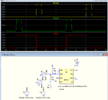This circuit is from make electronics esperiment 19 page 185. It automaticaly counts from 0 to 9 and is supposed to stop when pressing the stop button and waits until the start button is pressed again to continue counting.
It works but the stop button only works while being pressed which makes the start button useless.
Now, the top 555 is a bistable timer, it's supposed to be off and i turn it on by pressing the stop button and off by pressing the start. It's connected to the stop counting pin 2 of the 4026 chip. If the pin 2 is low then the chip starts counting, so that explains why it starts as soon as the power is on, but if i press stop then it's supposed to go high and stay "stopped", why does it starts as soon as I let go of the button?
I have a logic probe that i have just used for the first time and i've put it on the pin 2, it's low when counting and when i press the stop button it goes high, but doesn't stay high. It turns low in the same amount of time as the counting. Is there a connection with the lower 555 chip that turns it low automatically? Or is it that the upper 555 chip is in monostable mode, but this is bistable right? It's suppose to stay on.
How can I make the counter stop by pressing the stop button and make it wait until I press the start button?
Last edited:


